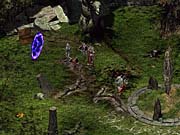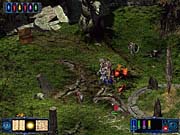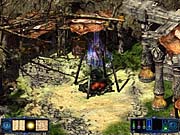Pool of Radiance: Ruins of Myth Drannor Updated Preview
Check out a video interview with associate producer Chuck Yager, and read all the details on the latest build of Pool of Radiance.
See it in motion!
The setting and story behind Ruins of Myth Drannor are rooted deeply in the history of the Forgotten Realms, the popular D&D campaign setting. In keeping with the established gameworld, Stormfront Studios has converted authentic D&D maps of the area into accurate, explorable replicas of this section of the Moonsea. Myth Drannor is what remains of an ancient elven city, whose populace fell victim to some horrible fate. By no means limiting, this part of the Realms makes for a varied environment--Myth Drannor was home to many races and cultures, including elves, dwarves, humans, and monsters.
The tale unfolds as the city of New Phlan, liberated by adventurers in the original game, is overrun by a malicious entity that has rekindled the magic behind the Pool of Radiance. The Pool of Radiance is an artifact of great power that has been used as a portal to send all manner of beasts and monsters into the heart of New Phlan. The mage Elminster summoned a band of adventurers led by the hero Athan to Myth Drannor, but Athan's band was horribly decimated shortly after its arrival. It's up to your party of adventurers to investigate their fate and take up the quest to destroy the Pool and the source of New Phlan's troubles. Who is behind these events is a mystery, although all indications lead one to believe that this new threat is an evil sorceress with a penchant for keeping the company of dragons.

Pool of Radiance: Ruins of Myth Drannor has adopted a look and feel that is unique within the genre. Its characters come to life in true-to-scale 3D form and nicely reflect the feel of the fantasy setting, and attack animations vary widely based on the weapon and skills of the character performing them. Basic spells like magic missile and bless utilize impressive particle effects. Getting your party caught in a cloudkill trap will fill the screen with shifting, hazy fog, replete with multiple layers of transparencies. Voice actors also take nearly every opportunity to bring the characters and creatures of Pool of Radiance to life. Orcs argue among themselves before attacking, and they can be overheard plotting if an ear is put to the proper door. Otherworldly beasts parley with your party, often allowing you to avoid combat, while others will merely taunt you before initiating attack. The environments are expansive maps, heavily detailed and filled to the brim with encounter areas and special locations. For instance, the area above the first dungeon houses a small tower, a trader's wagon, a secluded shrine, and a number of other surprises. The map screen allows you to scroll and zoom through the maps, as well as attach small notes to specific areas.
Compared with other games in the genre, Pool of Radiance has adopted an unintuitive gameplay format for examination and performing actions. When examining a chest, for instance, you must right-click on the chest and select from a pull-down menu whether or not to open it, smash it, or just take a look. Currently, the menus are simple in appearance, for the most part white text over a black background. During combat, actions other than the basic attack must be selected via hotkeys and pull-down menus--there is no icon-based interface for these functions. On the other hand, the simplified descriptions for items are to the point and practical.
What's New in 3rd Edition

Character creation in Pool of Radiance II is a relatively simple affair that yields characters with the potential for extensive growth. Along with the initial four characters, two more NPCs may join the adventure. As in the 3rd Edition rules, half-orcs are available as a race, with penalties to charisma and intelligence offset by an incredibly useful strength bonus. The character classes of monk, sorcerer and barbarian are also available. Monks are masters of unarmed combat, and at higher levels, they can outdo nearly any weapon with their bare hands. Sorcerers take the place of the 2nd Edition mage in Pool of Radiance, and they can select from their entire repertoire of spells at any given moment, without worrying about the standard wizard's spell-memorization requirements. Barbarians are the hardiest form of warrior, trading off the ability to use heavier armors for their unique talents. Your attributes are selected using a point system, so all starting characters, including those you meet during multiplayer games, will have begun on equal footing and can either be exceptionally good at a small number of things or well rounded, excelling at many skills. Those familiar with the standard paper-doll character sheets will find the fully 3D miniatures and incredibly useful information screens welcome additions. Every figure is modeled according to its equipment--characters with different items will have contrasting textures and unique animations based on what is currently worn. While magic items are simplified and don't have individual background stories attached to them, the items themselves vary greatly.

The 3rd Edition D&D rules are adhered to strictly, but they've been adapted well to the turn-based combat system. Characters are allowed full and partial actions, which can be used as desired for movement, attacks, the quaffing of potions, inventory management, or the use of skills. The addition of feats and skills is significant to combat, if only because warriors are more versatile and now have more available to them than the attack command. Paladins, for example, can apply their charisma modifiers to a single attack to smite evil, or they can trade off attack modifiers against particularly tough enemies to deal extra or even maximum damage. When surrounded, monks can use their excellent reflexes to deal out attacks of opportunity against foes who foolishly try to maneuver away from them. Not to be outdone, low-level spellcasters have been given the use of 0-level spells--cantrips for sorcerers, orisons for clerics. Spells like detect magic and light that would have once taken a valuable first-level slot away from magic missile are now available in substantial quantities. Sorcerers can even make minor attacks on the undead with their cantrips, while clerics can apply their orisons toward additional healing or other effects.
Pool of Radiance: Ruins of Myth Drannor's use of an in-game dungeon master and its adherence to the rules of the pen-and-paper game lend it the feel of a genuine D&D dungeon crawl. The DM takes the place of the traditional voiceless RPG narrator, and it relays clues that may not be readily apparent onscreen. For example, the DM will go into great detail describing the taste of brackish stagnant water if you were to drink it. Pool of Radiance also compensates for the lack of a sense of touch by conveying the feeling of bitter cold that sends a chill through your bones if you encounter the undead. The DM narrates the transitions into new areas during exploration and frequently provides necessary information for completing puzzle-oriented quests.
The sequel to Pool of Radiance is trying to bring the addictive formula from the gold-box D&D games to modern fruition, and it appears to be on the right track. Pool of Radiance: Ruins of Myth Drannor is nearly finished and currently scheduled for release in September. Take a look at our video interview with the developers and stay tuned for a review upon release.
Got a news tip or want to contact us directly? Email news@gamespot.com
Join the conversation